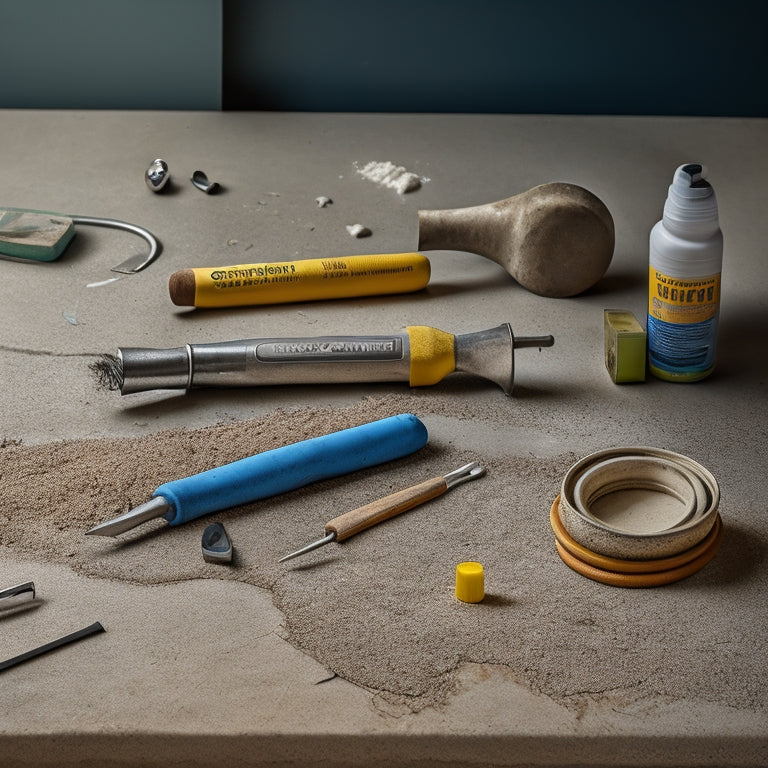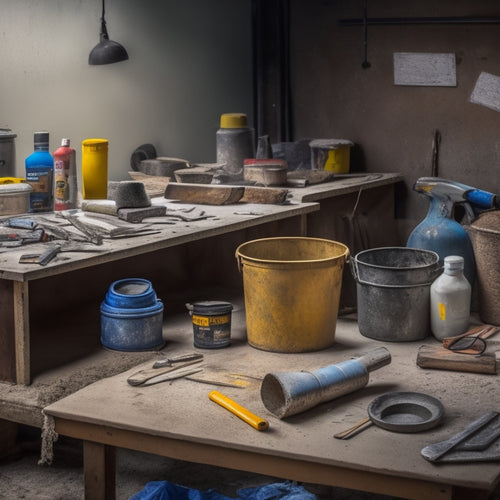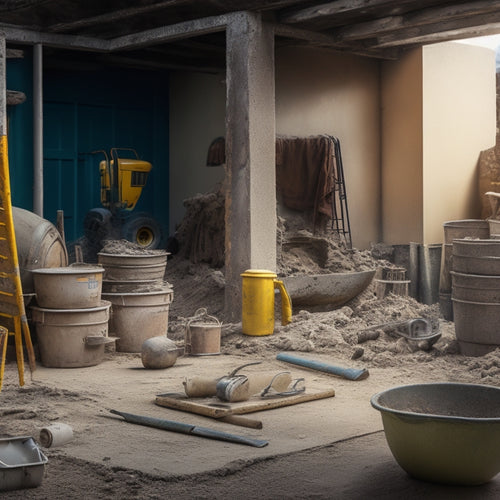
7 Best Budget-Friendly Tools for Concrete Repair
Share
You can greatly reduce your concrete repair tool costs by selecting the right budget-friendly options. For demolition, consider affordable chisel sets with heavy-duty, heat-treated steel blades or chrome vanadium steel blades, depending on the concrete thickness. Cost-effective sealant application guns, like pneumatic, manual, or electric guns, can help you apply sealants efficiently. You'll also need a budget-friendly mixing bucket, an inexpensive trowel, and a DIY-friendly epoxy injection kit. Additionally, opt for economical concrete patching compounds and reliable safety gear, such as puncture-resistant gloves and safety glasses, to guarantee a successful project. By choosing these tools, you'll be well on your way to completing your concrete repair project without breaking the bank.
Key Takeaways
• Affordable chisel sets with durable blades and proper maintenance can effectively demolish concrete without breaking the bank.
• Choosing the right sealant application gun depends on the type of sealant and application technique for optimal results.
• Mixing buckets with smooth interior surfaces and non-stick coatings simplify the cleaning process and prevent concrete residue buildup.
• Selecting the correct trowel material and ergonomic design can improve efficiency and reduce fatigue during concrete repair tasks.
• Economical concrete patching compounds can provide reliable fixes for filling holes, gaps, and cracks in concrete without overspending.
Affordable Chisel Sets for Demolition
When tackling concrete repair projects, you'll likely need to demolish existing structures, and a reliable chisel set is vital for this task. Prices for chisels range from under $20 to over $100, depending on the quality and type of chisels included.
To guarantee you get the most out of your investment, it's imperative to choose chisel materials that suit your specific needs. For instance, if you're working with thick concrete, you'll want chisels with heavy-duty, heat-treated steel blades. On the other hand, if you're working with thinner materials, lighter-duty chisels with chrome vanadium steel blades may suffice.
Proper chisel maintenance is also key to extending the lifespan of your tools. Regularly clean and lubricate your chisels to prevent rust and corrosion. Store them in a dry place, away from direct sunlight, and avoid mixing them with other tools to prevent damage.
Additionally, consider investing in a chisel set with a durable carrying case or pouch to keep your tools organized and within reach. By following these chisel maintenance tips and choosing the right materials, you'll be well-equipped to tackle even the most demanding concrete demolition projects.
Cost-Effective Sealant Application Guns
After demolishing the existing structure with your trusty chisel set, you'll need to apply sealants to fill gaps and cracks, and a cost-effective sealant application gun is the perfect tool to get the job done efficiently and effectively.
When selecting a sealant application gun, consider the type of sealant you'll be using and the application technique required. Different guns are designed for specific sealant types, such as silicone, polyurethane, or acrylic. Some guns are better suited for vertical applications, while others are designed for horizontal or overhead use.
| Sealant Type | Recommended Application Gun |
|---|---|
| Silicone | Pneumatic gun with adjustable flow control |
| Polyurethane | Manual gun with high-pressure output |
| Acrylic | Electric gun with precision nozzle control |
Budget-Friendly Mixing Bucket Options
When selecting a mixing bucket for your concrete repair project, you'll want to take into account the bucket's material options, which can range from heavy-duty plastic to sturdy metal.
You'll also need to reflect on the size and capacity of the bucket, as this will impact how much material you can mix at once and how efficiently you can work.
Bucket Material Options
You'll find that concrete repair projects often start with a sturdy mixing bucket, and the material it's made of can greatly impact your budget and workflow.
When it comes to bucket material options, you have a few choices to evaluate. Polypropylene buckets are a popular choice due to their affordability and durability. They're resistant to cracks and can withstand heavy use. However, they may become brittle over time, especially when exposed to extreme temperatures.
Steel buckets, on the other hand, offer exceptional durability considerations. They're heavy-duty and can withstand rough handling, making them ideal for large-scale concrete repair projects. However, they can be prone to rust and require more maintenance than polypropylene buckets.
When it comes to bucket cleaning techniques, look for buckets with a smooth interior surface to prevent concrete from sticking. A bucket with a non-stick coating can also make cleaning a breeze.
Regardless of the material you choose, make sure to clean your bucket thoroughly after each use to prevent concrete residue from building up and affecting future mixes.
Size and Capacity
With your bucket material selected, consider the size and capacity that will best suit your concrete repair project's specific needs, as this will directly impact your workflow and budget.
You'll want to choose a bucket that can hold the right amount of mixed concrete for your repair dimensions. A bucket that's too small will require frequent refills, slowing you down, while one that's too large may be unwieldy and waste materials.
For small to medium-sized repairs, a 2-3 gallon bucket is often ideal. It's large enough to mix a decent amount of concrete but still easy to handle.
For larger repairs, you may need a 5-gallon or larger bucket. Consider the size of your mixing tool as well, as a larger bucket may require a longer handle to guarantee efficient mixing.
Inexpensive Trowel Selection Guide
When selecting an inexpensive trowel for concrete repair, you'll want to contemplate the material options available, as they can affect the tool's durability and performance.
You'll also need to think about the handle's ergonomic design, which can impact your comfort and control during extended use.
Trowel Material Options
Selecting the right trowel material for concrete repair is crucial, as it directly impacts the tool's durability, performance, and cost.
You'll typically find trowels made from steel, stainless steel, or aluminum. Steel trowels are the most affordable option, but they can rust if not properly maintained. Stainless steel trowels, on the other hand, are resistant to corrosion and ideal for working with acidic or alkaline materials. Aluminum trowels are lightweight and durable, making them perfect for large projects.
When choosing a trowel material, consider the type of concrete repair you'll be doing. For example, if you're working with rough, aggregate-filled concrete, a steel or stainless steel trowel might be a better option. For smaller, smoother repairs, an aluminum trowel could be the way to go.
Remember to follow proper trowel maintenance tips, such as cleaning and storing your trowel properly, to extend its lifespan. Additionally, consider a trowel size comparison to guarantee you're getting the right tool for the job.
Handle Ergonomic Designs
You'll find that ergonomic handle designs can greatly reduce fatigue and discomfort during extended concrete repair projects, making them an essential consideration when choosing an inexpensive trowel. A well-designed handle can make all the difference in your overall comfort and performance.
Look for handles with contoured grips that fit snugly in your hand, allowing for a secure hold and reduced slippage. This is especially important when working with heavy or dense concrete mixes.
A comfortable handle grip is vital, as it enables you to maintain control and precision throughout the repair process. Opt for handles with cushioned or textured grips to minimize fatigue and blisters.
Additionally, consider handles with adjustable angles or rotating heads, which can help reduce strain on your wrists and arms. By prioritizing handle comfort and grip, you can work more efficiently and effectively, even on the most demanding concrete repair projects.
When selecting an inexpensive trowel, don't compromise on ergonomic design – your hands and body will thank you.
DIY-Friendly Epoxy Injection Kits
By leveraging epoxy injection kits specifically designed for DIY applications, homeowners and contractors can efficiently repair cracks and damages in concrete structures at a fraction of the cost of professional services.
These kits usually include a variety of epoxy types, each suited for specific repair tasks, such as flexural or compressive strengthening. You'll find epoxies with different viscosities, pot lives, and cure times, so it's vital to choose the right one for your project.
When applying epoxy injection kits, it's important to follow proper application techniques to guarantee a successful repair. This includes preparing the surface, mixing the epoxy, and injecting it into the crack or damage.
You'll need to use specialized equipment, such as injection ports and pumps, to achieve the desired results. By following the manufacturer's instructions and taking the necessary precautions, you can achieve professional-grade repairs with these DIY-friendly epoxy injection kits.
With the right tools and techniques, you can restore your concrete structures to their original strength and durability, saving you time and money in the long run.
Economical Concrete Patching Compounds
When tackling small to moderate-sized repairs, turn to economical concrete patching compounds that offer a cost-effective solution for filling holes, gaps, and cracks in concrete surfaces. These compounds are perfect for DIYers and professionals alike, providing a reliable fix without breaking the bank.
Here are some key features to evaluate when selecting an economical concrete patching compound:
| Compound | Setting Time | Eco-Friendly |
|---|---|---|
| QuickFix | 15-30 minutes | |
| EcoPatch | 1-2 hours | |
| RapidRepair | 30-60 minutes | |
| GreenSeal | 2-4 hours |
As you can see, there are various options available, each with its own unique characteristics. If you're looking for a fast-setting compound, QuickFix or RapidRepair might be the way to go. If you're more concerned about the environmental impact, evaluate EcoPatch or GreenSeal, which offer eco-friendly options. Regardless of your choice, these economical concrete patching compounds will help you get the job done without sacrificing quality or your budget.
Cheap yet Reliable Safety Gear
As you prepare to tackle concrete repairs, don't forget to prioritize your safety with affordable yet reliable gear that protects you from hazardous materials and falls.
You'll need safety gear essentials that won't break the bank, but still provide excellent protection. Start with budget safety accessories like gloves, which should be puncture-resistant and have grip to prevent slipping. A pair of safety glasses with anti-fog coating will protect your eyes from debris and chemicals.
Don't overlook a dust mask or respirator to filter out airborne particles. A hard hat is a must-have for overhead protection, and steel-toed boots will keep your feet safe from heavy objects.
Look for gear that meets industry standards, such as OSHA and ANSI guidelines. You can find affordable options at hardware stores or online retailers.
Frequently Asked Questions
How Do I Prevent Concrete Dust From Spreading During Demolition?
When you're about to demolish concrete, you'll want to prevent dust from spreading. To do this, you'll need to implement effective dust control methods.
Start by wetting the area with a hose to minimize airborne particles. Then, use a dust-containment system or plastic sheeting to enclose the demolition zone.
Don't forget to wear personal protective equipment, like respirators and safety goggles, to guarantee demolition safety.
Can I Use a Regular Drill for Mixing Concrete Patching Compounds?
When tackling tricky tasks, you'll want to choose the right drill for the job.
Can you use a regular drill for mixing concrete patching compounds? While a standard drill might seem sufficient, it's not the most suitable selection.
Opt for a drill with a high torque output, like a hammer drill or impact driver, to effectively mix thick compounds.
Employ a slow and steady mixing technique to avoid air pockets and guarantee a strong bond.
What Is the Ideal Temperature for Applying Epoxy Injection Kits?
When applying epoxy injection kits, you'll want to guarantee the ideal temperature for peak epoxy curing.
Typically, this range falls between 65°F to 85°F (18°C to 30°C). Temperature effects can greatly impact the curing process, so it's essential to avoid extreme temperatures.
If it's too cold, curing will slow down; if it's too hot, the epoxy may cure too quickly, leading to uneven results.
Make certain to check the manufacturer's recommendations and adjust accordingly.
How Often Should I Clean My Concrete Repair Tools to Maintain Quality?
When it comes to tool maintenance, you'll want to establish a regular cleaning frequency to guarantee your concrete repair tools remain in top condition.
You should clean your tools after every use, or at least daily, to prevent the buildup of dried concrete and epoxy residues.
This will help maintain their quality and extend their lifespan, allowing you to achieve consistent, high-quality results in your repair projects.
Are Concrete Repair Tools Available for Rent or Only for Purchase?
You're thinking, 'I don't want to break the bank on tools I'll only use once.' Relax, you don't have to!
Concrete repair tools aren't just available for purchase; you can also rent them. In fact, many equipment rental companies offer a range of tool options for short-term rentals.
This way, you can access the tools you need without the hefty upfront cost. Rental options vary by location, but you'll often find tool availability for tasks like drilling, grinding, and mixing.
Conclusion
You've made it to the end of our list of budget-friendly tools for concrete repair. With these affordable options, you can tackle even the most challenging projects without breaking the bank.
Did you know that according to the American Concrete Institute, concrete repair is a $2.2 billion industry? That's a lot of cracked sidewalks and crumbling foundations!
By choosing the right tools, you can get the job done efficiently and effectively, without sacrificing quality or your wallet.
Related Posts
-

3 Best Tools to Buy for Concrete Repair Online
When buying tools for concrete repair online, you'll want to research multiple retailer options to find the best prod...
-

Best Tools for Concrete Restoration and Repair
When tackling concrete restoration and repair projects, you need a range of reliable tools to achieve professional-gr...
-

What Tools Are Needed for Concrete Wall Foundations
You'll need a thorough array of tools and equipment to construct a concrete wall foundation that meets structural int...


